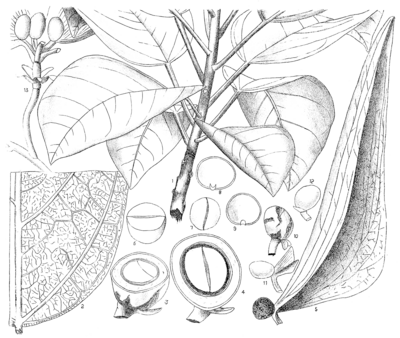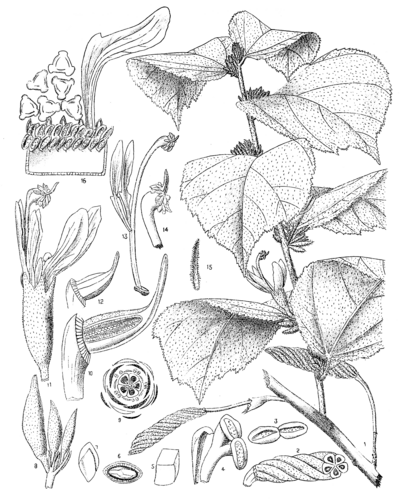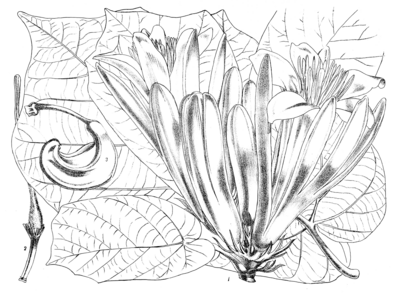Indian Medicinal Plants/Natural Order Sterculaceæ
N. 0. STERCULIACEÆ.
178. Sterculia fœtida, Linn, h.f.b.i., i. 354, Roxb. 510.
Vern. : — Jangli-badám (H. and M.) ; Jungli-badám, pún (Bomb.) ; Kuo-mhad, virhoi (Goa) ; Goldaru, nágalkuda (M) ; Pinári, kuddurai-pudduki, kudra-plukku, pinari-marum (Tam.) ; Gurapu-badam (Tel) ; Bhatala penari (Kan.)
Habitat : — Western and Southern India, Burma, Ceylon.
A large deciduous tree. Bark thin, white. Wood grey, spongy, soft. Branches whorled, horizontal. Leaves digitate, crowded at the ends of branches. Leaflets 7-9, elliptic lanceolate, about 6 by 2in., pubescent when young, adult glabrous beneath. Petioles 3in. Stipules ensiform, caducous. Panicles erect, numerous-flowered, spreading (formed immediately under the leaves of the present year, Roxb.), branches glabrous, ultimate pedicels shorter than the flower, jointed in the middle. Bracteoles minute. Flowers polygamous, red, yellow or dull purple. Calyx deeply 5-parted, ½-¾ in. diam., dull orange coloured, campanulate ; lobes oblong-lanceolate, spreading, villous within, much longer than the tube. Anthers 12-15. Carpels 5 downy ; style curved. Follicles as large as the fist, woody, scarlet, oblong, boat-shaped, shortly beaked, villous inside, nearly glabrous outside. Seeds black, 10-15, in each follicle. Cotyledons thick, fleshy ; albumen 0.
Flowers dull orange. Smelling most offensively, with the odour of carrion. The great pendulous bright red follicles gaping open and showing the black seeds which are very striking objects (Trimen). The seeds are eaten roasted.
Parts used : — The leaves, seeds and follicles.
Uses : — The leaves are considered as repellent and aperient. Loureiro informs us that the seeds are oily, and when swallowed incautiously they bring on nausea and vertigo. Horsfield adds that the capsule is mucilaginous and astringent. (Ainslie.)
179. S. urens, Roxb. h.f.b.i., i. 355, Roxb. 507.
Vern. : — Gúlú, kúlú, gúlar, buli (H.) ; Odla (Ass.) ; Pándrúka, kándol, karái sárdol, sárdora (Bomb.) ; Makchúnd ; Gur karanj (Mundari,) Tele {Ho) ; Búrkúnda (Mundari) (Bomb.) ; Kavalee talbsu (Tel.) ; Vellay pútali (Tam.) ; Kalru (Ajmir).
Habitat : — N. W. India, Assam, Behar, Eastern and Western Peninsulas, Ceylon dry country.
A large deciduous tree. " Bark ½ in. thick, very smooth, white or greenish grey, exfoliating in large thin irregular papery flakes. Wood very soft, reddish brown, with an unpleasant smell, with light coloured sap wood, always feels wet or oily. Pores large, often oval and sub-divided, very scanty, frequently filled with gum. Medullary rays moderately broad, on a radial section prominent as long, dark undulating bands, giving the wood a mottled silver-grain ; the distance between the rays is larger than the transverse diameter of the pores. Alternate dark and light concentric bands across the rays " (Gambled The bark gives good fibre. The colloid gum is called Katira. Leaves crowded at the ends of branches, tomentose beneath, nearly glabrous above, ; simple, cordate, shallowly-palmately- 5-lobed ; lobes entire, acuminate, blade 8-12in., petiole 6-10in. long. Flowers yellow, small, in crowded, erect, more or less pyramidal dense panicles, clothed with a dense sticky tomentum of glandular stellate hairs ; a few flowers bisexual, mixed with a large number of male flowers. Staminal-column short ; anthers about 20. The gynophore short, thick. Calyx ¼ in. diam., campanulate, 5-parted, lobes acute, spreading. Fruit 4-5 follicles, yellow-pubsecent, sessile, radiating, ovoid, thickly coriaceous. Carpels, 3 in. long, red when ripe, covered outside with stiff stinging bristles. Seeds 3-6 in each carpel, oblong, dark brown. This tree is often associated with Boswellia throughout the Peninsula (Brandis).
Uses : —The leaves and tender branches steeped in water yield a mucilaginous extract, useful in pleuro-pneumonia in cattle (Watt.)
The gum, known as karai-gond, is used as a substitute for tragacanth in Bombay (Dymock).
The Santals consider the gum a useful medicine in throat affections. (Revd. A. Campbell.) Causes intolerable itching, if touched or handled ; oil removes the hairs, and the itching, effectually (J. J. Wood's Plants of Chutia Nagpur, p 85 )
180. S. scaphigera, Wall, h.f.b.l, i. 361.
Habitat : — Chittagong.
A tall, deciduous, glabrous tree. Leaves glabrous, oblong-lanceolate, 1-nerved, 12-14 by 6 in., coriaceous, base rounded. Petiole 4-5 in., thickened at the top. Flowers panicled. Calyx ¼in., pilose, campanulate, five-parted, lobes reflexed. Male flowers : — -Stamens 10-15. Anthers 16-15, pilose. Ovary villous on a long slender stalk, 2-celled, with a ring of sessile anthers at the base. Style filiform ; Stigmas 2-lobed, subcapitate. Follicles large, leafy, boat-shaped, dilated at the base, opening-long before maturity, at first pilose, ultimately 6-8 by 3-4 in., venose-reticulate, 1-2 seeded. Seeds globose, solitary, albuminous ; cotyledons pale-green, radicle next the hilum.
Part used : — The fruit.
Use : — The fruit is used is China as a remedy for dysentery.
181. Helicteres isora, Linn,, h.f.b.l, i. 365., Roxb. 506.
Sans. : — Avartani.
Vern. : — Marosi, marorphali, jonka-phali, kapási, bhendu (H.); Antamorá (B.) ; Vurkatee (Sind.); Dhameenee (Dec); Murad Shing (Maráthi) ; Kawun (Bomb.) ; Aita (Gond) ; Valum-birikai (Tam.) ; Gubadarra (Tel.)
Habitat : — Dry forests throughout Central and Western India, from Behar as far west as Jammu, and the Western Peninsula. In the Thana Adawlat Garden (1881) there is a beautiful plant six feet high. K.R.K. Ceylon low country.
Arborescent or shrubby. Leaves 3 by 2½ in., bifarious, obliquely cordate, roundish, obovate, often lobed, shortly acuminate, serrate, scabrous above, pubescent beneath ; petiole ¼ in., as long as the linear subulate stipules. Peduncles 2-3 together, in a short axillary cyme. Bracteoles small, subulate. Flowers 1½in. Calyx gibbous, laterally compressed, somewhat 2-lipped. Petals reflected, red at first, fading to lead colour, very unequal in size. 2 lower the largest, claw winged. Staminodes 5 emarginate scales. Stamens 10. anthers ovate. Ovary at the top of the Staminal-column, 5-lobed, 5-celled. Styles awl-shaped, more or less united, slightly thickened and stigmatose at the tips. Ovules many in each cell. Follicles spirally twisted, cylindric. beaked, pubescent.
Parts used : — The fruit, root, and bark.
Uses : — The fruits are made into liniment for sores of the ear (Ainslie. )
They are also internally administered for colic, according to the ancient "doctrine of signatures."
Sloane speaks of the juice of the root having virtues in empyema and stomach affections. Leaves are used in Jamaica for decoction for clysters (Murray.;
In the Konkan it is used in snake-bite and diabetes (Dymock). It is also used in an thelmintic diarrhœa, dysentery, hose of powdered bark one wâl* to ¼ tola.
The root and bark used by the Santals for the same purposes as the fruit (Revd. A. Campbell.)
According to Moodeen Sheriff, it is demulcent and mild astringent, and useful with other drugs in the griping of bowels, and flatulence of children.
182. Pterospermum suberfolium. Lam, , h.f.b.l, i. 367.
Syn. : — P. canescens, Roxb. 512.
Sans. : — Moochukunda.
Vern. : — Muchukunda, muskunda (B.) ; Bælo giringa (Uriya) ; Lolagu (Tel.) ; Taddo (Tam) ; Muchkand (H. and B.) ; Naji (Burm.) ; Velenge, venangu (Sing.) ; Muchkund (Marathi).
Habitat : — Western Peninsula (Konkan and Kanara). Forests of Orissa. The N. Circars ; the Carnatic; Burma. Ceylon, dry low country.
- A uv7/=4 to fi grains (Jeweller's weight in Western India.) It is the scarlet seed of Adenanthera pavonin, Linn.
A moderate-sized tree, with thick longitudinally cracked bark. Wood light red, moderately hard. Branchlets and in- florescence densely clothed, with fine ferruginous or tawny stellate hairs. Leaves distichous, 2-4 in., from a rounded base ovate-oblong, acuminate, often irregularly lobed in the upper part, upperside glabrous, underside white or yellowish, filled with fine stellate hairs. Flowers yellowish-white, sweet-scented, peduncles short, axillary, sometimes bearing 2-3 flowers ; bracteoles, deciduous, linear. Sepals linear, fleshy, brown tomentose 4-5 in. long, ⅓-½ in. broad. Petais a little larger then the sepals, but brown and thinner, white. Capsule 2-3 in. long, ¾ in. diam., attenuate into a stalk ½-¾ in. long, tapering at apex to a point, brown velvety. Seeds winged, numerous.
Use : — The flower made into a paste with kanjika(rice vinegar) forms an application for hemicrania (Dutt).
In the Concan, the flowers and bark of this, and P. acerifolium, are charred and mixed with kamala and applied in suppurating small-pox. (Dymock.) The sweet scent of the flowers is due to the small glands on the outer side of the thickened sepals. The sepals are much used by the Bombay High-class ladies in their hair on account of the lasting fragrance of the glands, (K. R. K )
183. P. acerifolium, Willd., h.f.b.i., i. 368, Roxb. 158.
Sansk : — Karnikara.
Vern. : — Kanak-champa, kaniar, katha-champa (FT.) ; Machkunda (Santal) ; Laider (Michi.) ; Karni-kara, kanak-champa (Bomb.) ; Matsa kanda (Tel.); Toungpetwun, tha-majam weisoke (Burm.).
Habitat :— From the N. W. Himalaya in Kumaon, to Chittagong and Concan.
A tall evergreen tree. " Bark thin grey, smooth. Sap- wood white ; heart wood soft to moderately hard, red. Pores scanty, small oval or elongated, generally sub-divided, visible on a longitudinal section. Medullary rays fine, very numerous, undulating, not prominent, uniform, equidistant. Innumerable very fine concentric lines {Gamble). Leaves obovate, polymor phous, cordate or peltate, coarsely-toothed, palmately nerved, glabrous above, white tomentose beneath ; blade 10-40in. by 6-12 in. ; petioles 5 in. long, stout. Flowers axillary, very large, and fragrant. Sepals linear brown tomentose without, paler within, 6 by 5in. Petals white, shorter than the sepals. Staminodes club-shaped, stouter and longer than the filamented anthers. Staminal- column glabrous, l-5in. long, filaments slender. Gynophore longer than the staminal-column. Ovary 5-angled, densely brown -tomentose ; style long, stout with a club-shaped stigma ; ovarian cells many-ovuled. Capsule 4-6 in. long, 5 angled ; 5-celled. Seeds numerous, winged ; albumen mucilaginous, scanty ; cotyledons thin, folded. (Talbot. P. 149, Vol. I, Forest Flora, Bombay Presidency and Sind, 1909).
Parts used : — The leaves, bark, and flowers.
Uses : —The clown on the leaves is used to stop bleeding in wounds (Gamble). The flowers are used as a general tonic (T. N. Mukerji).
184. Pentapetes phœnicea, Linn, h.f.b.i., i. 371., Roxb. 157.
San. : — Raktaka, Bandhuka, bandhujiva, arka-vallabha, pushpa rakta.
Vern. : — Kat-lálá, Doopahuria (B.) ; Guidu. Paria (Pb.) Bare baha (Santal) ; Tâmbdi dupári (Mar.) ; Nág-pu (Tam.) ; Dopahariya, dopohoria (H.}; Bare baba {Santal);
Habitat : — Throughout the hotter parts of India.
Annual herbs, branched, 2-5 ft., glabrous, or with a few scattered stellate hairs. Leaves 3-5 in., 1-nerved, crenate-serrate, petiole lin. Stipules subulate. Peduncle simple, axillary, as long as or longer than the petiole, 1-2-flowered, jointed near the flower. Bracteoles half the length of the Calyx. Flowers red, opening at noon and closing at the following dawn. Hence in Bombay it is called Dupári or Madhuk. (See A collection of Marâthi Poems, Navanita, page 406, 4th edition, Bombay). Sepals 5, stellate-hairy, with a few bristles, lanceolate. Petals 5, obovate. Stamens 20, connate at the base, 15 fertile in groups of 5 each, alternating with 5 staminodes, which are nearly as long as the petals. Anthers 2-cellecl, extrorse ; style entire, twisted ; Stigmas 5. Capsule subglobose, bristly, half the length of the persistent Calyx, 5-valved, dividing longitudinally. Seeds 8-12, 2-serrate in each cell ; not winged. Cotyledons plaited, 2-partite.
Parts used : — The fruit and root.
Uses : — The fruit is officinal on account of its mucilaginous properties. The root is employed as a medicine by the Santals (Revd. A. Campbell).
185. Eriolœna quinquelocularis, Wight. H.F.B., i. 371.
Vern : — Bhâwât (Chutia Nagpur).
Habitat : — Behar ; Western Peninsula, chiefly on the west side, from Bombay southwards ; Chutia Nagpur ; Nilghiri Mts. Belgaum Ghâts (S. Mahratta country), Coimbatore.
A tree, herbaceous portions stellate hairy. Leaves roundish, toothed, apex acute, shortly acuminate, base cordate, 2½-3 in., each way, palmately-7-nerved, thinly stellately hairy or glabrascent above, whitish and softly pubescent beneath. Petioles 2in. Bracteoles a little distant from the flower, minute, caducous, entire or lobed. Cymes at end of branches ; peduncles longer than the leaves ; stellate-hairy. Pedicels shorter than the flower, jointed above the middle. Flower-buds ovate, oblong. Sepals fin. Petals equalling sepals ; claw broad, pubescent. Column as long as the petals. Stigma revolute, 5-10-lobed. Style hairy. Capsule l¼in., oblong, pointed, 5-10-valved ; valves not tubercled, usually villous at the angles. Seeds numerous. Flowers in July and August.
Use : -Poultice of root heals wounds (J. J. Wood's Plants of Chutia Nagpur, p. 85).
186. Abroma augusta, Linn., h.f.b.i., i. 375, Roxb. 510.
Syn. : — A. fastuosurn, Gœrtn.
vern. : — Ulatkambal (B.) ; Olatkambol (Bomb.)
Habitat: — Throughout the hotter parts of India, from the N. W. Provinces to Sikkim, Khasia Mountains, and Assam. Unknown in the Western Peninsula of India.
A small tree native or cultivated throughout the hotter parts of India. Branches and branchlets downy. The bark yields a beautiful silky fibre like that of hemp, and the shrub has often been recommended for growth as a crop. Wood light brown, soft. Pores moderate-sized, subdivided usually into 2 or 3 partitions. Medullary rays very short, brown, and very fine, bent round the pores whose diameter is greater than the distance between them" (Gamble). Leaves 4-6 by 4-5in., repand, denticulate, ovate from a cordate base, often lobed or angled ; basal nerves 5-7, upper smaller, narrower, entire, glabrescent above, soft-pubescent below. Petiole ½-1in. Stipules linear, dociduous, as long as petiole. Inflorescence soft-pubescent. Peduncles " extra axillary " (Brandis), with two or three purple bisexual flowers. Flowers 2in. diam. Sepals 1in., persistent, lanceolate, free nearly to the base. Petals covered in bud, deciduous ; claw concave. Staminal-tube short, 4-petaloid. Staminodes alternating with sessile anthers. Capsule 1½in., obpyramidal, ultimately glabrous, thrice as long as the persistent Calyx, membranous, 5-angled, 5-winged.
Parts used : — The root, bark and leaves.
Uses: — The root-bark has been brought to notice as an emmenagogue by Mr. B. M. Sircar, in the Indian Medical Gazette, for 1872. In the Lit G. for May 1900, he wrote :— " Forty years ago I first came to know the medicinal properties of this indigenous plant as a good emmenagogue in menstrual disorders. . . . The officinal part of the plant is the fresh viscid sap, which abounds in the thick, easily seperable bark of the root and is insoluble in water. " . . . I have generally used the medicine during the period of the menses, commencing from two days before its appearance (when the pain precedes the flow) three days during the flow and two days after its cessation. In case of no premonitory pains, the medicine is given from the first day of the flow for seven days successively with equally good results.
'A single administration daring the menses generally cures the disease and brings on conception in young married women
"Attempts have been made to administer the drug in the more acceptable forms of tincture, pill or powder, but none prove so efficacious as the fresh viscid sap in substance, in which form I have used it with wonderful results.
"Menstrual disorders, and notably the varieties of dysmenorrhœa, are very prevalent in this country, and it seems nature has supplied it with a simple efficacious medicine by endowing the roots of an indigenous plant with such singular virtues. It is noteworthy that the roots branch out in numerous tender offshoots, superficially under the ground, and can be easily taken out in abundance."
Dr. J. H. Thornton considers that it is useful in the congestive and neuralgic varieties of dysmenorrhea, and that it regulates the menstrual flow and acts as an uterine tonic. It should be given during menstruation, with black pepper. The dose is said to be half a drachm of the fresh viscid juice of the root-bark (Am. Journ. Med. Sci., p. 276, 1873).
The infusion of fresh leaves and stems in cold-water is demulcent, and very efficacious in gonorrhœa (Surgeon Meadows, in Watt's Dictionary.)
187. Guazuma tomentosa, Kunth, h.f.b.i, i. 375.
Vern. : — Nipal tunth (Beng.) Of the bark : — Bandoq-ke- jhár-ki chhal (Dec.) ; Tain-pûchli-pattai (Tam.) ; Udrik-patta (Tel.) ; Rudrakshi (Kan.). Habitat:—Generally distributed, and frequently cultivated in the warmer parts of India and Ceylon.
A small tree, a native of Tropical America, but frequently cultivated in the warmer parts of India and Ceylon. Bark brown rough. Wood white or yellowish or light brown, soft, even-grained. Annual rings faintly marked. Pores moderate-sized, fairly numerous, often subdivided. Meduallary rays moderately broad to broad, not numerous, conspicuous in the silver-grain on a radical section. The tree is easily grown and propagated, "planted or run wild," adds Gamble. Herbaceous portions tomentose. Leaves from an unequal-sided base, obliquely cordate, ovate-oblong or lanceolate, acuminate, serrate, scabrid or glabrescent above, pubescent beneath; base 5-7-nerved; petiole short. Flowers numerous, small, yellow and purple in terminal and axillary panicles, which are twice the length of the leaves; or in multifid cymes. Flower-buds globose. Calyx 1½ in. bell-shaped, stellate-hairy; sepals ultimately reflexed; petals exceeding the Calyx, claw concave. 5 Petaloid Staminodes alternating with 5 filaments each, bearing several anthers. Anthers concealed in the hood of the petals. Capsule 5-valved, lin. long, oblong obtuse, or ovoid, woody, with obtuse black tubercles, resembling a mulberry.
Part used:—The bark.
Use:—In Martinique, the infusion of the old bark is esteemed as a sudorific, and as useful in cutaneous diseases and diseases of the chest (Lindley.)
The bark is tonic and demulcent, and is used with benefit in some of those cases in which calumba and gentian are indicated (Moodeen Sheriff.)
The inner bark is esteemed as a remedy for elephantiasis in West Indies (Watt.)
N. O. TILIACEÆ.
188. Grewia tiliœfolia, Vahl. H.F.B.I., I. 386, Roxb. 431.
Sans.:—Dharmana, Dhanurvriksha; Dhanvan.

STERCULIA FŒTIDA, LINN.

STERCULIA FŒTIDA, LINN.

STERCULIA URENS, ROX B.

STERCULIA SCAPHIGERA, WALL.

HELICTERES ISORA, LINN.

PTEROSPERMUM SUBERIFOLIUM, LAM.

PTEROSPERMUM ACERIFOLIUM, WILLD.

A—GREWIA VILLOSA, WILLD. B—ERIOLÆNA QUINQUELOCULARIS, WIGHT.

Pentapetes Phœnicea, LINN.

ABROMA AUGUSTA, LINN.

GUAZUMA TOMENTOSA, KUNTH.